Introduction to Prolog
- 1. INTRODUCTION TO PROLOG - Brian Hutchinson Present by - W.J.A.I.U. Jayaweera- 100227D G.K.M.C Sajeewa- 100470N M.M.D.T.K Wijewardane- 100612E
- 2. OUTLINE Introduction Language Features More Features Behind the scenes Language Classifications Examples
- 3. INTRODUCTION Prolog is the most popular language of the logic programing languages. It is goal based language, it has automatic backtracking and uses recursion. Prolog stands for programmation en logique", or programming in logic."
- 4. INTRODUCTION [CTD...] Invented by Alain Colmerauer and Philippe Roussel of the Groupe d'Intelligence Articielle (GIA) in early 1970s. The earliest Prolog interpreter was written in Algol in1972 by Roussel. The official ISO standard for Prolog was published in 1996.
- 5. CURRENT IMPLEMENTATIONS There are several popular Prolog interpreters available. They include: GNU Prolog (http://pauillac.inria.fr/vdiaz/gnu- prolog/) SWI-Prolog (http://www.swi-prolog.org/) Visual Prolog (http://www.visual- prolog.com/vip6/Download/Default.htm) BProlog (http://www.cad.mse.kyutech.ac.jp/people/zhou/bpr olog.html)
- 7. LANGUAGE FEATURES[CTD...] Facts-Something that is declared to always be true. Ex-father(bob,george) mother(alice,jeffrey) Rules- Something which is true only if all conditions (sub goals) on the right are true Ex- parent(X,Y) :- father(X,Y). parent(X,Y) :- mother(X,Y). grandparent(X,Z) :- parent(X,Y), parent(Y,Z).
- 8. LANGUAGE FEATURES[CTD...] Questions- Something which asks from the system Ex- ?-ancestor(X,cindy),sibling(X,jeffrey) Clauses- Something which has a head and a body. Fact = head Rules = head + body Question=body
- 9. LANGUAGE FEATURES [CTD...] Ex- uncle(X,Y) :- sibling(X,Z), parent(Z,Y). (head) (body) ?- ancestor(X,cindy),sibling(X,jeffrey) (body) father(john,mary) (head)
- 10. LANGUAGE FEATURES[CTD...] Terms - term can be number, constant (Albert) or variable(X). Compound Terms- data structure, convenient way of grouping relevant data together Ex- fullname( joe,brown ) student( fullname( joe,brown ), 25 ) Full name , Student are called as functors.
- 11. MORE FEATURES Order- order matters in prolog, order is top to bottom. Ex- dog(rover). dog(duke). We enter the following question: ?- dog(X). Answer : X = rover Order is important for the efficiency and correctness of the program.
- 12. MORE FEATURES[CTD...] Backtracking- prolog stores data in tree. It uses depth first search to find answers. In its attempt to prove a goal, Prolog sometimes goes down a dead-end, at which point it needs to backtrack.ck
- 13. MORE FEATURES[CTD...] Ex- Sample Code Facts- green(poisonivy). green(broccoli). edible(icecream). edible(broccoli). Question- ?- green(X),edible(X). Answer- X = broccoli
- 14. MORE FEATURES[CTD...] Execution trace- ?- green(X),edible(X). 1 1 Call: green(poisoniyy) ? 1 1 Exit: green(poisonivy) ? 2 1 Call: edible(poisonivy) ? 2 1 Fail: edible(poisonivy) ? 1 1 Redo:green(poisonivy)1 1 1 Call: green(broccoli) ? 1 1 Exit: green(broccoli) ? 2 1 Call: edible(broccoli) ? 2 1 Exit: edible(broccoli) ? Green(p) Edible(p) Green(b) Root Edible(b) Answer
- 15. MORE FEATURES[CTD...] Cuts- The cut is denoted by exclamation mark “!” and disallows prolog from backtracking past that point. Ex- With Out Cut grade(G,a) :- G > 90. grade(G,b) :- G > 80. grade(G,c) :- G > 70. grade(G,d) :- G > 60. grade(_,f). With Cut grade2(G,a) :- G > 90, !. grade2(G,b) :- G > 80, !. grade2(G,c) :- G > 70, !. grade2(G,d) :- G > 60, !. grade2(_,f).
- 16. MORE FEATURES[CTD...] Forced Backtrack With Grade ?- grade(83,X) X = b; X = c; X = d; X = f yes Forced Backtrack With Grade2 ?- grade2(83,X) X = b; yes Forced back tracking with semi colon. Types of Cuts Red Cuts Green Cuts
- 17. MORE FEATURES[CTD...] Recursion- like functional languages prolog uses recursion. Ex- ancestor(X,Z) :- parent(X,Z). (Base Case) ancestor(X,Z) :- parent(X,Y),ancestor(Y,Z). (Recursive Rule)
- 18. MORE FEATURES [CTD...] Lists- important data structure in prolog and are processed recursively. Ex- [a, b, a, a, c, d] [] [the, dog] List= Head + Tail List= [Head | Tail ] Ex- List- [a,b,a] can be represented as [a | [b,a] ] or [a, b | [a]] or [a, b, a | []]
- 19. MORE FEATURES [CTD...] There are several other features in prolog Negation Assertion and Retract
- 21. RESOLUTION AND UNIFICATION Resolution The resolution principle, If C1 and C2 are Horn clauses and the head of C1 matches one of the terms in the body of C2 then we can replace the term in C2 with the body of C1. Example : takes(Saman, cs123). classmates(X, Y) :- takes(X, Z), takes(Y, Z). classmates(Saman, Y) :- takes(Y, cs123).
- 22. RESOLUTION AND UNIFICATION [CTD…] Unification Prolog associates variables and values using a process known as unification Variables that receive a value are said to be instantiated Example : The pattern-matching process used to associate variable X with Saman and Z with cs123 is known as unification.
- 23. RESOLUTION AND UNIFICATION [CTD…] The unification rules for Prolog : A constant unifies only with itself. Two structures unify if and only if they have the same functor and the same number of arguments, and the corresponding arguments unify recursively. Example : ?- f(a, b) = f(a, b, c). No A variable unifies with anything.
- 24. DEPTH FIRST SEARCH Prolog uses a depth-first search strategy when traversing the tree. Advantage : Less memory usage Disadvantage : Prolog may descend down an endless branch (Black holes)
- 25. TOP DOWN VERSUS BOTTOM UP Top Down Control we start from the goal and attempt to reach the hypotheses Bottom Up Control we start with the hypotheses and attempt to reach the goal
- 26. BOTTOM UP CONTROL Example : Method for calculating a fibonacci number, Starting with the bases cases and accumulating until it reaches the goal. fib(0,1). fib(1,1). fib(N,F) :- N=M+1, M=K+1, fib(M,G), fib(K,H), F=G+H, N>1. :-fib(3,F). N=3, M=2, K=1, F = G + H :-fib(2,F). N=2, M=1, K=0, F = G + H :-fib(1,F). F = 1 :-fib(1,1). :-fib(0,F). F = 1 :-fib(0,1). :-fib(1,F). F = 1 :-fib(1,1).
- 27. COMPILING PROLOG CODE A program exists called wamcc, based on the Warren Abstract Machine. C code may then be compiled to produce stand alone executable. GNU Prolog logo
- 28. STRENGTHS OF PROLOG [CTD…] Simplicity of Prolog Ability to model certain problems very concisely and elegantly Capability of solving problems that it wasn't originally designed to solve Ability to manipulate symbolic data
- 29. STRENGTHS OF PROLOG [CTD…] Prolog’s strength to manipulate symbolic data: “There are well-known examples of symbolic computation whose implementation in other standard languages took tens of pages of indigestible code. When the same algorithms were implemented in Prolog, the result was a crystal-clear program easily fitting on one page.” ‒ Bratko
- 30. WEAKNESSES OF PROLOG Lack of structure Issues with readability of Prolog code serious implications for the readability and declarativeness of code due to cut predicate (!). Inefficiency of Prolog code Logical imperfectness
- 32. HIERARCHY OF LANGUAGES According to Programming Language Pragmatics by Michael L. Scott, Declarative functional Lisp/Scheme ML Haskell dataflow Id Val logic Prolog VisiCalc
- 33. HIERARCHY OF LANGUAGES [CTD…] Imperative von Neumann Fortran Pascal Basic C Object-Oriented Smalltalk Eiel C++ Java
- 34. SCOPE Scope of a variable in scope within a clause Scope of the head of each clause in global scope Scope of constants in global scope • Example 1. hates(X,Y) :- friends(X,Z),hates(Z,Y). 2. loves(X,Y) :- hates(X,Z),hates(Y,Z).
- 35. TYPE SYSTEMS Prolog is dynamically typed. At runtime, if a built-in predicate is given the wrong type of argument an error will occur. For example: 1. ?- X is 1+1. X = 2 Yes 2. ?- X is 1+dog. uncaught exception: error(type_error(evaluable,dog/0),(is)/2)
- 36. TYPE SYSTEMS [CTD…] A term can be quarried to find out its type with Prolog in the following way: ?- number(5). yes ?- number(dog). no ?- var(X). yes ?- var(5). no
- 37. BINDINGS Variable Cells A variable is stored in a single heap cell. This cell contains a tag and a store address of the that which it is bound to. Unbound variables, by convention, point at their own cell. 3 REF 5 2 REF 2
- 38. BINDINGS [CTD…] Structure Cells A non-variable term is stored in a structure cell. For a structure f(t1:::tn), there will be n + 2 cells in the heap. 0 STR 1 1 f/n 2 REF 2 …… …… …… …… n + 1 REF n + 1
- 39. EXAMPLES 1. Implementing the Towers of Hanoi problem 2. Implementing a non-deterministic finite state automaton
- 40. TOWERS OF HANOI In this puzzle, we have three pegs and several disks, initially stacked from largest to smallest on the left peg
- 41. Our goal is to move the entire tower to the middle peg We can only move one disk at a time We can use right peg to temporally hold the disks We can never place a larger disk on a smaller disk in any peg
- 42. A B C
- 43. A B C
- 44. A B C
- 45. A B C
- 46. A B C
- 47. A B C
- 48. A B C
- 49. A B C
- 50. Recursive solution - Move N - 1 discs from stack 1 to 3 with the help of stack 2. - Move the Nth disc from 1 to 2 - Move N - 1 discs from stack 3 to 2 with the help of stack 1
- 51. Implementation in Prolog hanoi(N) :- dohanoi(N, 1, 2, 3). dohanoi(0, _ , _ , _ ) :- !. dohanoi(N, A, B, C) :- N_1 is N-1, dohanoi(N_1, A, C, B), moveit(A, B), dohanoi(N_1, C, B, A). moveit(F, T) :- write([move, F, -->, T]), nl.
- 52. Output when n=3 ?- hanoi(3). [move,1,-->,2] [move,1,-->,3] [move,2,-->,3] [move,1,-->,2] [move,3,-->,1] [move,3,-->,2] [move,1,-->,2] yes
- 53. Output when n=4 ?- hanoi(4). [move,1,-->,3] [move,1,-->,2] [move,3,-->,2] [move,1,-->,3] [move,2,-->,1] [move,2,-->,3] [move,1,-->,3] [move,1,-->,2] [move,3,-->,2] [move,3,-->,1] [move,2,-->,1] [move,3,-->,2] [move,1,-->,3] [move,1,-->,2] [move,3,-->,2] yes
- 56. accepts(State,[]) :- final(State). accepts(State, [X|Rest]) :- trans(State,X,State1), accepts(State1,Rest). accepts(State, String) :- silent(State,State1), accepts(State1,String).
- 57. Questions we can ask 1) Whether a given string is accepted by the automaton ?- accepts(s1,[a,a,a,b]). yes
- 58. Questions we can ask (cont.) 2) What states can we start in if we accept a certain string? ?- accepts(S,[a,b]). S = s1; S = s3
- 59. Questions we can ask (cont.) 3) What are all strings of length 3 that can be accepted by the automaton? ?- accepts(s1,[X1,X2,X3]). X1 = a X2 = a X3 = a; X1 = b X2 = a X3 = b yes
- 60. CONCLUSION Prolog is the most popular language of the logic programing languages. It is a declarative logic programming language It is goal based language, it has automatic backtracking and uses recursion.
- 61. THANK YOU
Editor's Notes
- #7: A Prolog program consists of facts, rules (relationships), and questions (goals),all of which are clauses.
- #8: The first line states that bob is the father of george, the second line states that alice is the mother of jeffrey. Facts represents the data base of the programme.The comma denotes the logical and relationship. For example, the third rule says that X is the grandparent of Z if X is the parent of some Y, and Y is the parentof Z. Notice that in Prolog variables begin with an upper-case letter. Rules based on facts. Complex rules are based on simple rules
- #9: These question (or goal) is asking: is there somebody, X, who is an ancestor of cindy, where this same X is a sibling to jerey.Prolog will combine facts and rules to answer this question.Facts rules and questions are altogether called as clauses.
- #10: 1- rule2-quetsion3-fact
- #11: Prolog variable are upper case letters.Compound terms are user as data structures. 1- contains first name and last name 2- full name + age
- #12: In a pure logic programming language, order does not affect the meaning ofthe program. However, as you will see in later section, in Prolog order is veryimportant for the effciency and even the correctness of the program
- #17: The semi-colon, in a sense, tells Prolog to imagine that the solution it came upwith had failed. Prolog then backtracks and attempts to find another solution.In grade 2 forced backtracking did not work due to the cut.
- #20: Programmers may add or remove clauses from a program dynamically, withassert and retract. Retract(C) removes the firrst instance of clause.Assert typically has two forms, asserta(C) and assertz(C), which insert clause C at the beginning and end of the program, respectively
- #21: In this section we consider a variety of topics about, how Prolog does what it does, strengths weaknesses
- #22: These are two approaches use with Prolog when proving goalsHorn clauses is a clause who’s,head is true if the body is true
- #23: B) The process use to associate variables and values in Prolog is unification.A) In Prolog,saying that two terms are equal is saying that they are unifiable.
- #24: A) If the other thing has a value, then the variable is instantiated. If the other thing is an uninstantiated variable, then the two variables are associated in such a way that if either is given a value later, that value will be shared by both.
- #25: B) The process of backtracking which was mentioned, is essentially a traversal of a tree.A) DisadvantageEndless branches will, preventing it from ever finding the solution
- #26: B) There are two principal ways in which,sub goals can be generated: top-down - recursive and bottom-up - iterativeA) Prolog uses the technique of bottom-up control
- #27: B) Bottom-up method, more iterative more efficient
- #28: B) wamcc compiles Prolog code to C code
- #29: 3rd point - The flexibility to choose which variables to instantiate in a goal make4th point – This makes it a very useful tool for artificial intelligence applications
- #32: In this section Prolog will be classified according to, its place in the language hierarchy,its scope, bindings and type systems.
- #33: B) Main two types: Declarative ImperativeA) Prolog is a Declarative – Logic language
- #35: B) In Prolog there are no,procedures other typical blocks of code therefore concept of scope is a little different for Prolog1) Each X refers to the same thing in first lineThe variable X in line one has nothing to do with the X in line two2) The head of each clause can be either a fact or part of a ruleThe predicate hates(X;Z) in second line refers to the same predicate in the first line
- #36: A) In the first case checks whether, 1+1 equals 2In the second case trying to checks solution for 1+dog, as argument type dog doesn’t match with the given predicate, Prolog produces an exceptionHowever, this program can be compiled with no problem, GNU Prolog compiler does no type-checking at compile time.All type checking would have to occur at run-time.
- #38: B) Terms in Prolog are stored in an “addressable heap”.There are, variable cells structure cells
- #39: A) f is the functorti are the remaining items in this data structure, First, there will be a structure cell (denoted STR), which points to the address of the functor cell.Structure cell, and the functor cell need not be contiguous.The functor cell will always be followed by n contiguous blocks containing the cells of the terms ti.
- #40: 2 -> In theory of computing
- #41: Ancient, famousEverybody knows itJust to refresh ur memory
- #42: In this example, goal is moving the entire left stack to middle stack3 rules
- #50: We are done.But this is for n equals 3For a general solution we have to consider an arbitrary N value
- #51: In the general solution that can be implemented to solve using a computer, there are 3 steps involved1Pls remember our final goal is to move the stack 1 to stack 2 not to 323Recursive solution, we considering an arbitrary N valueMoving N-1 -> similar and smaller versionDoesn’t violate the rule: larger cant be on smaller
- #52: 1st rule -> start2nd -> terminate. Stopping condition3N A B C F T are variables4Write -> implemented function in prolog. Like println in javaNothing more is needed
- #53: Same as we did it manually
- #55: 2nd exampleImplementing ----- in prolog
- #56: Have to define some FactsConstants not variablesDefines this state diagramStore it in prolog
- #57: Basic function of FA to accept strings 1st -> no string
- #58: What we can get from this implementation
- #61: Declarative----- imperative




![INTRODUCTION [CTD...]
Invented by Alain Colmerauer and Philippe Roussel
of the Groupe d'Intelligence Articielle (GIA) in early
1970s.
The earliest Prolog interpreter was written in Algol
in1972 by Roussel.
The official ISO standard for Prolog was published
in 1996.](https://image.slidesharecdn.com/introductiontoprologfinal-131007230123-phpapp02/85/Introduction-to-Prolog-4-320.jpg)


![LANGUAGE FEATURES[CTD...]
Facts-Something that is declared to always be true.
Ex-father(bob,george)
mother(alice,jeffrey)
Rules- Something which is true only if all conditions
(sub goals) on the right are true
Ex-
parent(X,Y) :- father(X,Y).
parent(X,Y) :- mother(X,Y).
grandparent(X,Z) :- parent(X,Y), parent(Y,Z).](https://image.slidesharecdn.com/introductiontoprologfinal-131007230123-phpapp02/85/Introduction-to-Prolog-7-320.jpg)
![LANGUAGE FEATURES[CTD...]
Questions- Something which asks from the system
Ex- ?-ancestor(X,cindy),sibling(X,jeffrey)
Clauses- Something which has a head and a body.
Fact = head
Rules = head + body
Question=body](https://image.slidesharecdn.com/introductiontoprologfinal-131007230123-phpapp02/85/Introduction-to-Prolog-8-320.jpg)
![LANGUAGE FEATURES [CTD...]
Ex-
uncle(X,Y) :- sibling(X,Z), parent(Z,Y).
(head) (body)
?- ancestor(X,cindy),sibling(X,jeffrey)
(body)
father(john,mary)
(head)](https://image.slidesharecdn.com/introductiontoprologfinal-131007230123-phpapp02/85/Introduction-to-Prolog-9-320.jpg)
![LANGUAGE FEATURES[CTD...]
Terms - term can be number, constant (Albert) or
variable(X).
Compound Terms- data structure, convenient way
of grouping relevant data together
Ex- fullname( joe,brown )
student( fullname( joe,brown ), 25 )
Full name , Student are called as functors.](https://image.slidesharecdn.com/introductiontoprologfinal-131007230123-phpapp02/85/Introduction-to-Prolog-10-320.jpg)

![MORE FEATURES[CTD...]
Backtracking-
prolog stores data in tree.
It uses depth first search to find answers.
In its attempt to prove a goal, Prolog sometimes
goes down a dead-end, at which point it needs to
backtrack.ck](https://image.slidesharecdn.com/introductiontoprologfinal-131007230123-phpapp02/85/Introduction-to-Prolog-12-320.jpg)
![MORE FEATURES[CTD...]
Ex- Sample Code
Facts- green(poisonivy).
green(broccoli).
edible(icecream).
edible(broccoli).
Question- ?- green(X),edible(X).
Answer- X = broccoli](https://image.slidesharecdn.com/introductiontoprologfinal-131007230123-phpapp02/85/Introduction-to-Prolog-13-320.jpg)
![MORE FEATURES[CTD...]
Execution trace-
?- green(X),edible(X).
1 1 Call: green(poisoniyy) ?
1 1 Exit: green(poisonivy) ?
2 1 Call: edible(poisonivy) ?
2 1 Fail: edible(poisonivy) ?
1 1 Redo:green(poisonivy)1
1 1 Call: green(broccoli) ?
1 1 Exit: green(broccoli) ?
2 1 Call: edible(broccoli) ?
2 1 Exit: edible(broccoli) ?
Green(p)
Edible(p)
Green(b)
Root
Edible(b)
Answer](https://image.slidesharecdn.com/introductiontoprologfinal-131007230123-phpapp02/85/Introduction-to-Prolog-14-320.jpg)
![MORE FEATURES[CTD...]
Cuts- The cut is denoted by exclamation mark “!” and
disallows prolog from backtracking past that point.
Ex-
With Out Cut
grade(G,a) :- G > 90.
grade(G,b) :- G > 80.
grade(G,c) :- G > 70.
grade(G,d) :- G > 60.
grade(_,f).
With Cut
grade2(G,a) :- G > 90, !.
grade2(G,b) :- G > 80, !.
grade2(G,c) :- G > 70, !.
grade2(G,d) :- G > 60, !.
grade2(_,f).](https://image.slidesharecdn.com/introductiontoprologfinal-131007230123-phpapp02/85/Introduction-to-Prolog-15-320.jpg)
![MORE FEATURES[CTD...]
Forced Backtrack With Grade
?- grade(83,X)
X = b;
X = c;
X = d;
X = f
yes
Forced Backtrack With Grade2
?- grade2(83,X)
X = b;
yes
Forced back tracking with semi
colon.
Types of Cuts
Red Cuts
Green Cuts](https://image.slidesharecdn.com/introductiontoprologfinal-131007230123-phpapp02/85/Introduction-to-Prolog-16-320.jpg)
![MORE FEATURES[CTD...]
Recursion- like functional languages prolog uses
recursion.
Ex-
ancestor(X,Z) :- parent(X,Z).
(Base Case)
ancestor(X,Z) :- parent(X,Y),ancestor(Y,Z).
(Recursive Rule)](https://image.slidesharecdn.com/introductiontoprologfinal-131007230123-phpapp02/85/Introduction-to-Prolog-17-320.jpg)
![MORE FEATURES [CTD...]
Lists- important data structure in prolog and are
processed recursively.
Ex-
[a, b, a, a, c, d]
[]
[the, dog]
List= Head + Tail
List= [Head | Tail ]
Ex-
List- [a,b,a] can be represented as
[a | [b,a] ] or
[a, b | [a]] or
[a, b, a | []]](https://image.slidesharecdn.com/introductiontoprologfinal-131007230123-phpapp02/85/Introduction-to-Prolog-18-320.jpg)
![MORE FEATURES [CTD...]
There are several other features in prolog
Negation
Assertion and Retract](https://image.slidesharecdn.com/introductiontoprologfinal-131007230123-phpapp02/85/Introduction-to-Prolog-19-320.jpg)


![RESOLUTION AND UNIFICATION [CTD…]
Unification
Prolog associates variables and values using a process
known as unification
Variables that receive a value are said to be instantiated
Example :
The pattern-matching process used to associate variable X
with Saman and Z with cs123 is known as unification.](https://image.slidesharecdn.com/introductiontoprologfinal-131007230123-phpapp02/85/Introduction-to-Prolog-22-320.jpg)
![RESOLUTION AND UNIFICATION [CTD…]
The unification rules for Prolog :
A constant unifies only with itself.
Two structures unify if and only if they have the same
functor and the same number of arguments, and the
corresponding arguments unify recursively.
Example :
?- f(a, b) = f(a, b, c).
No
A variable unifies with anything.](https://image.slidesharecdn.com/introductiontoprologfinal-131007230123-phpapp02/85/Introduction-to-Prolog-23-320.jpg)



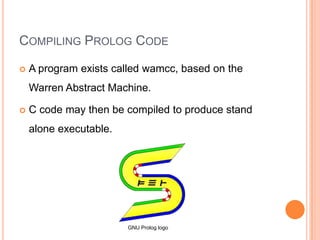
![STRENGTHS OF PROLOG [CTD…]
Simplicity of Prolog
Ability to model certain problems very concisely and
elegantly
Capability of solving problems that it wasn't
originally designed to solve
Ability to manipulate symbolic data](https://image.slidesharecdn.com/introductiontoprologfinal-131007230123-phpapp02/85/Introduction-to-Prolog-28-320.jpg)
![STRENGTHS OF PROLOG [CTD…]
Prolog’s strength to manipulate symbolic data:
“There are well-known examples of symbolic
computation whose implementation in other standard
languages took tens of pages of indigestible code.
When the same algorithms were implemented in
Prolog, the result was a crystal-clear program easily
fitting on one page.”
‒ Bratko](https://image.slidesharecdn.com/introductiontoprologfinal-131007230123-phpapp02/85/Introduction-to-Prolog-29-320.jpg)



![HIERARCHY OF LANGUAGES [CTD…]
Imperative
von Neumann
Fortran
Pascal
Basic
C
Object-Oriented
Smalltalk
Eiel
C++
Java](https://image.slidesharecdn.com/introductiontoprologfinal-131007230123-phpapp02/85/Introduction-to-Prolog-33-320.jpg)
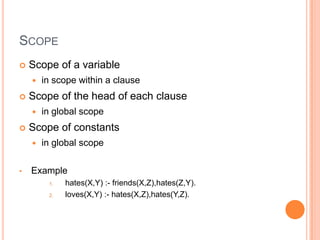

![TYPE SYSTEMS [CTD…]
A term can be quarried to find out its type with
Prolog in the following way:
?- number(5).
yes
?- number(dog).
no
?- var(X).
yes
?- var(5).
no](https://image.slidesharecdn.com/introductiontoprologfinal-131007230123-phpapp02/85/Introduction-to-Prolog-36-320.jpg)

![BINDINGS [CTD…]
Structure Cells
A non-variable term is stored in a structure cell.
For a structure f(t1:::tn), there will be n + 2 cells in the
heap.
0 STR 1
1 f/n
2 REF 2
…… ……
…… ……
n + 1 REF n + 1](https://image.slidesharecdn.com/introductiontoprologfinal-131007230123-phpapp02/85/Introduction-to-Prolog-38-320.jpg)


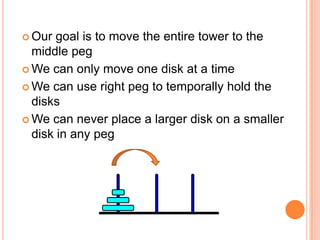
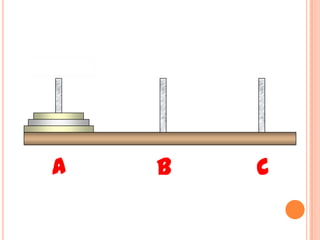


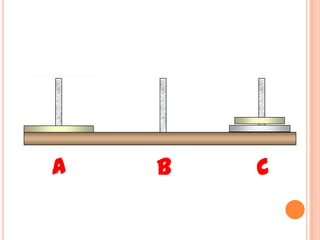

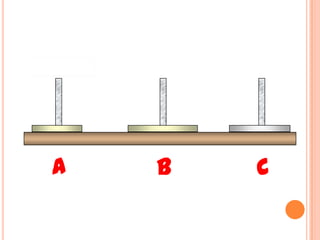

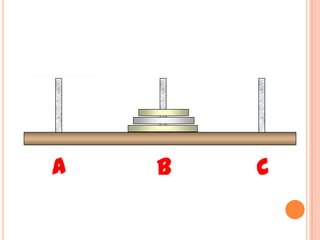

![Implementation in Prolog
hanoi(N) :- dohanoi(N, 1, 2, 3).
dohanoi(0, _ , _ , _ ) :- !.
dohanoi(N, A, B, C) :- N_1 is N-1,
dohanoi(N_1, A, C, B),
moveit(A, B),
dohanoi(N_1, C, B, A).
moveit(F, T) :- write([move, F, -->, T]), nl.](https://image.slidesharecdn.com/introductiontoprologfinal-131007230123-phpapp02/85/Introduction-to-Prolog-51-320.jpg)
![Output when n=3
?- hanoi(3).
[move,1,-->,2]
[move,1,-->,3]
[move,2,-->,3]
[move,1,-->,2]
[move,3,-->,1]
[move,3,-->,2]
[move,1,-->,2]
yes](https://image.slidesharecdn.com/introductiontoprologfinal-131007230123-phpapp02/85/Introduction-to-Prolog-52-320.jpg)
![Output when n=4
?- hanoi(4).
[move,1,-->,3]
[move,1,-->,2]
[move,3,-->,2]
[move,1,-->,3]
[move,2,-->,1]
[move,2,-->,3]
[move,1,-->,3]
[move,1,-->,2]
[move,3,-->,2]
[move,3,-->,1]
[move,2,-->,1]
[move,3,-->,2]
[move,1,-->,3]
[move,1,-->,2]
[move,3,-->,2]
yes](https://image.slidesharecdn.com/introductiontoprologfinal-131007230123-phpapp02/85/Introduction-to-Prolog-53-320.jpg)


![accepts(State,[]) :- final(State).
accepts(State, [X|Rest]) :- trans(State,X,State1),
accepts(State1,Rest).
accepts(State, String) :- silent(State,State1),
accepts(State1,String).](https://image.slidesharecdn.com/introductiontoprologfinal-131007230123-phpapp02/85/Introduction-to-Prolog-56-320.jpg)
![Questions we can ask
1) Whether a given string is accepted by the automaton
?- accepts(s1,[a,a,a,b]).
yes](https://image.slidesharecdn.com/introductiontoprologfinal-131007230123-phpapp02/85/Introduction-to-Prolog-57-320.jpg)
![Questions we can ask (cont.)
2) What states can we start in if we accept a certain
string?
?- accepts(S,[a,b]).
S = s1;
S = s3](https://image.slidesharecdn.com/introductiontoprologfinal-131007230123-phpapp02/85/Introduction-to-Prolog-58-320.jpg)
![Questions we can ask (cont.)
3) What are all strings of length 3 that can be accepted by
the automaton?
?- accepts(s1,[X1,X2,X3]).
X1 = a
X2 = a
X3 = a;
X1 = b
X2 = a
X3 = b
yes](https://image.slidesharecdn.com/introductiontoprologfinal-131007230123-phpapp02/85/Introduction-to-Prolog-59-320.jpg)

